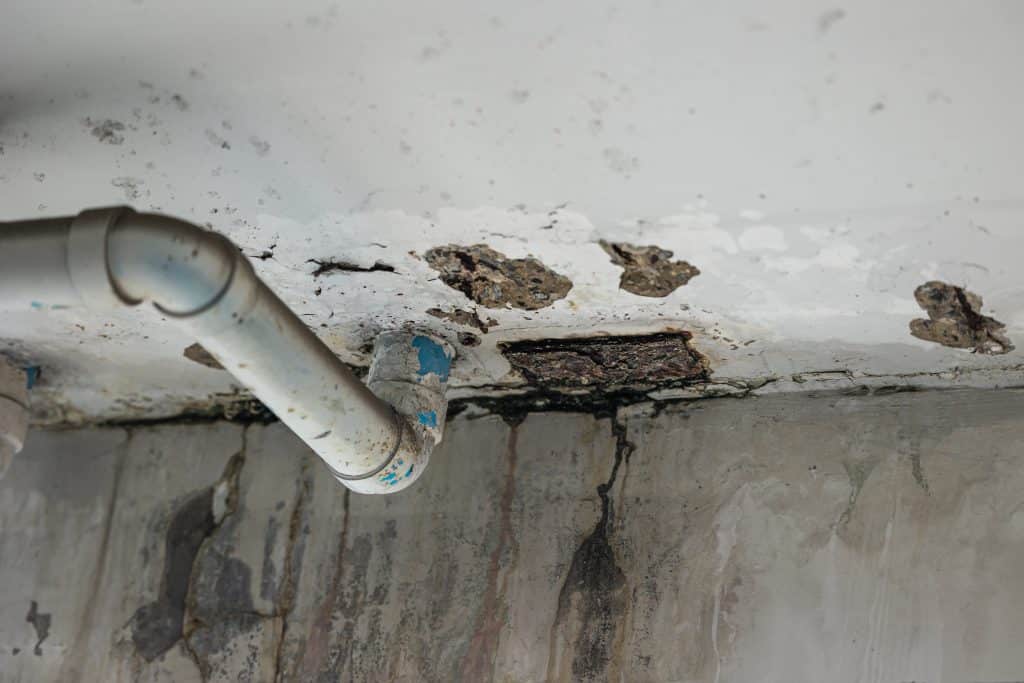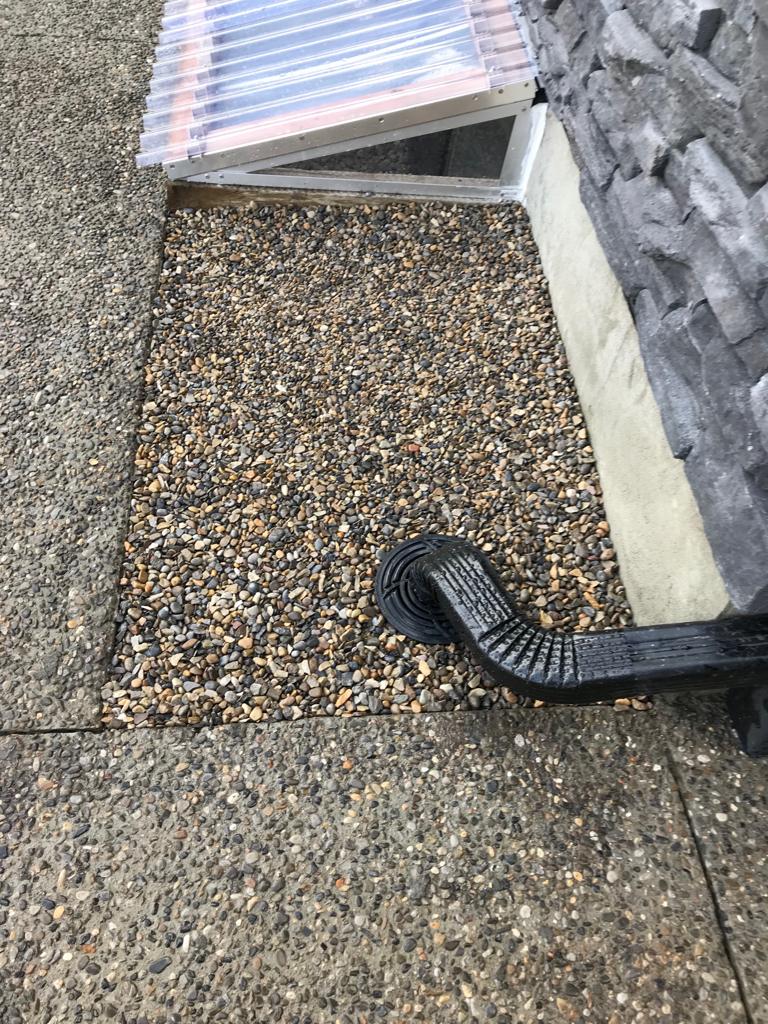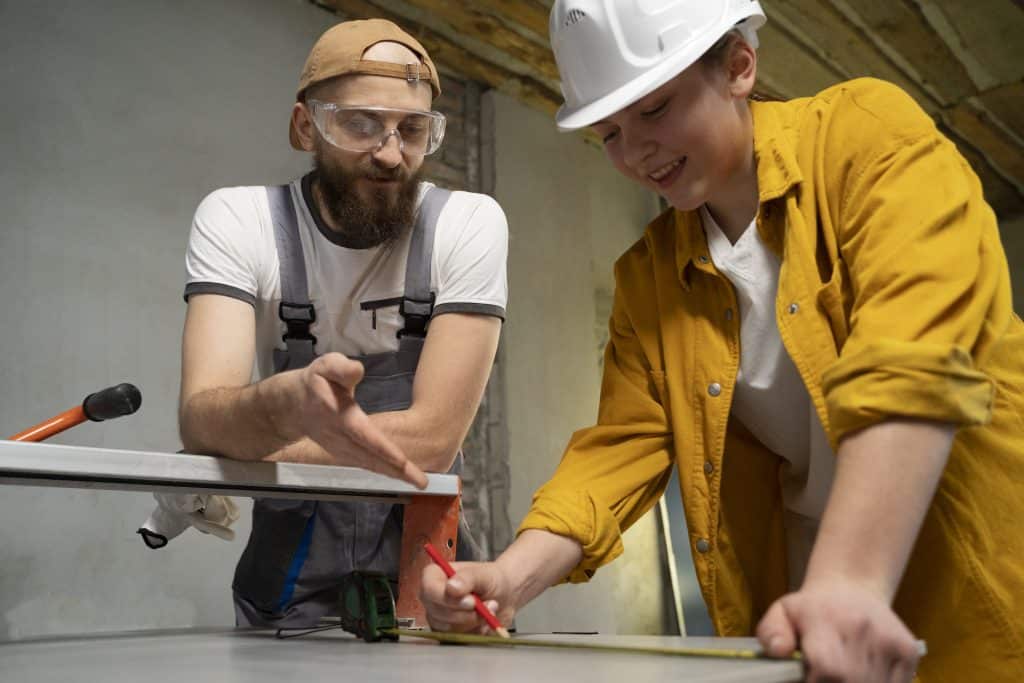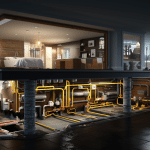Contents
A robust waterproofing system is a preventive measure and a strategic investment in the longevity and durability of your property. As a minimum, it will protect your home from unwanted moisture and subsequent damage. As a maximum, if it’s coupled with basement underpinning in Hamilton, it quickly pays off and generates monthly income.
Why Basement Leaks Appear
As always, there are multifaceted reasons behind basement leaks. Basements, the foundational level of our structures, inadvertently become susceptible to the various whims of nature and construction nuances.

#1. Hydrostatic Pressure
Hydrostatic pressure happens when water accumulates in the soil around the basement. The pressure forces water to pass through cracks, joints, and porous material, causing the leaks. It happens the most after heavy rainfall or a quick thawing of snow. This process weakens the structure stability and leads to moisture-related issues such as mold.
#2. Soil Contraction and Expansion
Having abstorbed water, the soil expands. It then exerts pressure against the foundation and basement walls. During drier periods the soil contracts. It leads to gaps through which water infiltrates during the next wet season. This perpetual cycle of contraction and expansion forces too much stress on the structural integrity, eventually causing the leaks and cracks in the basement.
#3. Faulty Construction Practices
Sometimes basement leaks might happen because of improper construction. It might be inadequate joint sealing, using low-quality materials, or a lack of proper drainage systems. Such overlooks during the construction lead to future issues like basement leaks, needing more repairs and interventions.
#4. Wall and Floor Joint Weakness
The place where the basement walls and floor meet is quite susceptible to leaks. As water in the soil applies pressure on the basement walls, it gradually descends, accumulating at this juncture, leading to potential seepage if the joint isn’t adequately sealed and reinforced during construction. If the crack appears in the joint, use epoxy crack injection to seal it. However, it might be better to consult basement waterproofing professional contractors.
#5. Window Well Leaks
In basements with below-grade windows, the window wells become a source of leaks if not properly managed. In there’s no proper sealing and drainage system, the rainwater or snow accumulate and lead to water infiltrating the basement. Proper window replacement helps mitigate this issue.
#6. Plumbing Mishaps
Not all leaks originate from external sources. Sometimes, the culprit lies within. Faulty plumbing, leaking pipes, old water heaters, or sewer line issues lead to a leaky basement, which is often blamed on external factors.
#7. Material Deterioration
With time, even the most sturdy of materials submit to the wear and tear. The gradual deterioration of the basement walls and floor materials – be it concrete, stone, or block – paves the way for water intrusion following water damage.
#8. Landscape Sloping
Surprisingly, the topography of your property can be a silent contributor to basement leaks. A landscape that slopes toward the building directs water toward the foundation, where it finds its way into the basement. Ensuring the landscape slopes away from the structure is a simple yet impactful preventive measure.
Basement Waterproofing Definition
Waterproofing is a combination of methodologies and processes we use to prevent basement water damage. Therefore, it’s a shield, an impermeable layer that obstructs water from infiltrating and causing potential structural damage.
Why Waterproofing Is Important?
Water, while life-sustaining, paradoxically is a subtle destroyer of your building. Its infiltration into structural elements like walls and foundations instigates many issues ranging from mold growth to structural instability.
Types of Waterproofing Systems
- Liquid membrane. It’s a thin coating consisting of a primer coat and two top coats, applied via roller, spray, or trowel. It offers more flexibility than the cementitious types of waterproofing
- Bituminous coating. It’s widely used for areas submerged in water. It’s an excellent protective coating, especially below the concrete surfaces
- Polyurethane liquid membrane. Offering higher flexibility, polyurethane is applicable for surfaces prone to alternating weather conditions, making it apt for flat roofs
- Cementitious waterproofing. Recognized for its robustness and ease of application, often employed in internal wet areas like toilets
Choosing the Right Waterproofing System
The selection of a suitable waterproofing system depends on numerous factors, prominently including the type of building, environmental conditions, and, specifically, the type of issue you’re confronting. Engaging with adept professionals like WillFix, acquainted with the technical and practical aspects, streamline your basement waterproofing in Toronto.

Avoiding Common Pitfalls
Inadequate surface preparation and improper application deter the system’s efficacy. A well-rounded approach, which englobes preparatory measures like surface cleaning, crack filling and foundation crack repair, and ensuring the substrate is in optimal condition, ensures the longevity and efficacy of the applied waterproofing system.
How Much Does Waterproofing Cost in Toronto?
The waterproofing cost in Toronto varies considerably, influenced by a the project scope and the waterproofing method. You can quickly learn about waterproofing cost in Toronto in regards to your particular case by contacting a specialist.

Basic Waterproofing Services
A baseline service, which might include applying a sealant and minor crack repair, potentially starts from CAD 300 – to CAD 500. This service is quite superficial and is fit better for preventive measures rather than addressing serious issues.
Interior Waterproofing
Interior waterproofing, often involving applying sealants and installing weeping tiles to manage water ingress, tends to be a cost-effective method in contrast to its exterior counterpart. Homeowners might expect to allocate approximately CAD 1,000 – CAD 5,000 for interior waterproofing solutions, with variance hinging on the complexity and scale of the undertaking.
Exterior Waterproofing
In Toronto exterior basement waterproofing ranges between CAD 100 – CAD 150 per linear foot, translating to a ballpark figure of CAD 10,000 – CAD 25,000 for an average-sized home, though exact costs surpass this estimate in more complex scenarios.
Basement Lowering or Underpinning
A complex process like basement underpinning or lowering is a considerable investment. This process does the waterproofing, also enhancing structural integrity and expanding the living space. In Toronto underpinning projects range from CAD 20,000 to CAD 100,000, mostly influenced significantly by basement size and construction materials.
Sump Pump Installation
Getting sump pump to protect your basement against flooding costs between CAD 1,000 to CAD 2,000 for the unit and installation. Additional elements like battery backup systems or more advanced models, elevate the cost.
French Drain Installation
Think about a French drain to redirect water away from the foundation. The price may hover around CAD 5,000 – CAD 15,000. The exact French drain cost will depend the drain length and the specifics of the installation process and factors like:
- The contractor’s pricing model
- Material costs
- Unforeseen challenges during the project
Better consult multiple waterproofing professionals in Toronto to ensure accurate financial planning. A comprehensive onsite assessment provides a more exact and reliable financial gauge specifically for your needs. The prices should be validated with a professional assessment to ensure accurate budgeting and optimal solution derivation.
Expert opinion
Evelyn J. Kiser
Evelyn is an expert with over 12 years of experience in basement lowering, foundation strengthening and waterproofing. She has earned a reputation as a professional who solves complex problems and knows the answers to all questions.
Undoubtedly, when your structure is shielded effectively against water and moisture, it assures an augmented lifespan and diminished maintenance costs in the long run. But the nuances of why you need it can be deeper than generally perceived. Ask a landscape architect to review your property and get valuable insists on naturally protecting your basement from water seepage.
Waterproofing System FAQ
-
What are the common types of waterproofing systems available in Canada?
The standard waterproofing systems include exterior waterproofing, interior waterproofing, concrete waterproofing, sump pumps and french drain systems, and bituminous coating.
-
Is interior waterproofing more effective compared to exterior waterproofing?
Interior waterproofing manages water that enters a building using drainage systems. It is less invasive and cheaper than exterior waterproofing, which prevents water from entering by sealing the foundation's exterior. Both are effective, depending on needs.
-
Are waterproofing systems necessary for new constructions in Canada?
Yes, waterproofing systems are essential for new constructions in Canada due to the climate, which has significant rainfall and snowmelt. They ensure long-term structural integrity and prevent costly repairs.
-
How long do waterproofing systems typically last?
Waterproofing systems in Canada generally last 20-30 years for the exterior, 10-20 years for the interior, and 5-20 years for other systems, depending on quality and maintenance.
-
When is it time to install a waterproofing system?
